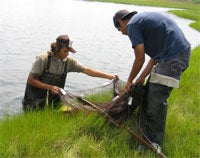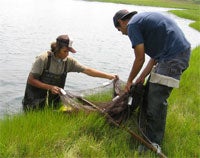 Ashaway resident aims for career as environmental lawyer
Ashaway resident aims for career as environmental lawyer
KINGSTON, R.I. – January 13, 2006 — Growing up in a Native American family, Cassius Spears developed a strong connection to the natural world and a passion for environmental protection.
“We’re a culturally-inclined family with a strong relationship with the natural world, ” said Spears, a sophomore environmental science major at the University of Rhode Island. “The environment has sustained my ancestors for many generations and still remains a major component of indigenous culture and traditions. I came to URI not only to get an education, but to protect our ability to get shellfish in a mudflat or forage for berries and mushrooms in the forest. For me, going to URI is an opportunity to protect a way of life.”
Spears, a resident of Ashaway, is already making his mark in environmental research. He just completed a six-month research project, in cooperation with Rick McKinney at the U.S. Environmental Protection Agency, assessing the value of wildlife habitat in Rhode Island salt marshes.
Spears studied the feeding behavior of two common wading birds – great egrets and snowy egrets – at salt marshes in Apponaug and Jamestown. Every day during the summer months he observed the birds through telescopes and binoculars and kept track of the time they spent on various activities – walking, flying, preening, stalking, and striking.
An analysis of his data showed that, while there were distinct differences in feeding behaviors between the two birds, both species were able to capture fish faster and with less effort at the Apponaug site, despite the fact that the Apponaug site faced much greater human disturbance.
“That could be partly due to the quantity of available feeding habitat,” Spears explained. “Wading birds prefer to feed in four to seven inches of water, which is what they found at Apponaug, but in Jamestown the marsh is deep and so they could only feed around the edges.
“Previous studies have also shown that the Apponaug site has very high nitrogen levels, which supports a high abundance of mummichogs, a salt marsh minnow, due to a greater abundance of microalgae,” he said. “This greater availability of food could also contribute to the differences we found.”
The results of Spears’ research will be used to help establish quantitative methods for assessing wetland quality and to benchmark conditions for wetland habitat restoration goals.
“It was a lot of fun and a valuable experience,” Spears said.
Spears’s research was funded by the URI Coastal Fellows Program, a unique program designed to involve undergraduate students in addressing current environmental problems. Now in its 10th year, the Coastal Fellows Program teams students with faculty, research staff and graduate students to help them gain skills that will ensure their future success.
Although Spears still has more than two years before he graduates from URI, he knows exactly what he wants to do in his career.
“I want to focus on ecology and ecosystems, but I plan to go to law school to become an environmental lawyer,” he said. “I’d love to work for the EPA, and even better I’d love to help out tribes across America in their environmental battles. You can do a lot as a research scientist, but the place you can really do some good is in the courtroom.”
Pictured above
URI students Cassius Spears (left) and Brandon Kape capture fish at a salt
marsh in Jamestown to assess the availability of food for wading birds.

